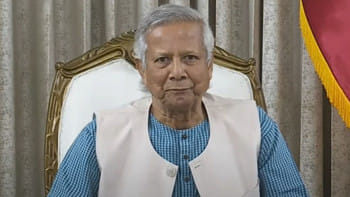Through Time and Tide

Boats: A Treasure of Bangladesh acts as a paean to the ancient, yet now sadly dying craft of naval carpentry in Bangladesh. Its roots in the region go back far enough for Ibn Battuta, the 14th century traveller from Morocco, to have remarked with a sense of wonderment in his Rihla (Travels), on the "innumerable" boats carrying men and merchandise, and the existence of a gigantic fleet of war-boats. From that we may safely infer that the Bengalis' particular penchant for boatmaking goes back even further. Thus through millennia, the naval carpenters of Bangladesh honed an expertise in designing and creating various makes of wooden boats that gave this small South Asian country what is now the largest fleet in world, as we learn in Boats.
A labor of love on part of the authors, Enayetullah Khan and Yves Marre, the book deals with various aspects of the boats of Bangladesh, ranging from the early history of water navigation in this part of the world, to the importance of preserving for future generations the rich cultural heritage associated with boats. Its five chapters manage to be comprehensive enough to give the reader an in-depth understanding of the importance of the naval carpenters' homespun genius, as well as the aesthetic sensibilities associated with their craftsmanship. The intrinsic relationship between the people of the region, and this simple yet indispensable form of transport, are conveyed through the folkloric aspects related to life in water. An account of the story of Manosamongol, where the rivalry of Chand Sadagor and Manasa Devi and the eventual victory of Behula takes us back to a time when all important things happened at least in the vicinity of water, is particularly effective in this endeavor.
Interviews with some of the last surviving boatmakers allow for some valuable insight into their lives and their craft. These are the people whose lifelong association with our river transport system can be a quintessential element in designing the future of transport and communications in our burgeoning nation, and in getting a better understanding about boats and their importance. Yet, these people are the ones most often overlooked by most people writing or talking about the subject. The advent of mechanized vessels in the age of commercialization renders them a decidedly rare species these days, and we even learn from the book that we may now be into the very last generation of master carpenters. The authors are thus to be commended for seeking them out.
It would be totally remiss to not mention the visual splendor contained within the pages of Boats, which adopts the coffee-table format without foregoing the intellectual discipline or rigor one associates with serious research, or delving into some of the technicalities involved in the matter at hand. The photographs have been meticulously sourced and chosen to reflect the subject in all its colorful glory, and even in dark despondence, they somehow manage to capture the ragged beauty of boats. A literature review is unnecessary, and thus not to be found here—mostly because very little literature existed at all on the subject before Messrs Khan and Marre came along. However, they certainly do not hesitate to convey their deep appreciation of others in Bangladesh and abroad who have been working relentlessly in the same field and making meaningful contributions over the years. Every now and then we come across short but significant pieces written by many of them.
Let us brook no illusions. It is almost certainly too late now to save or preserve the dying of our naval carpenters, or their craftsmanship. But the authors of Boats have presented us with an important and timely repository for the store of knowledge built up through time immemorial that they represent, passed on that knowledge through generation after generation. And even as we concede the inevitable march of the mechanized vessel, the idea of envisaging Bengal as a region remains incomplete without its ubiquitous wooden boats.
Shayan S. Khan is an editor at UNB/ Dhaka Courier.


 For all latest news, follow The Daily Star's Google News channel.
For all latest news, follow The Daily Star's Google News channel. 



Comments